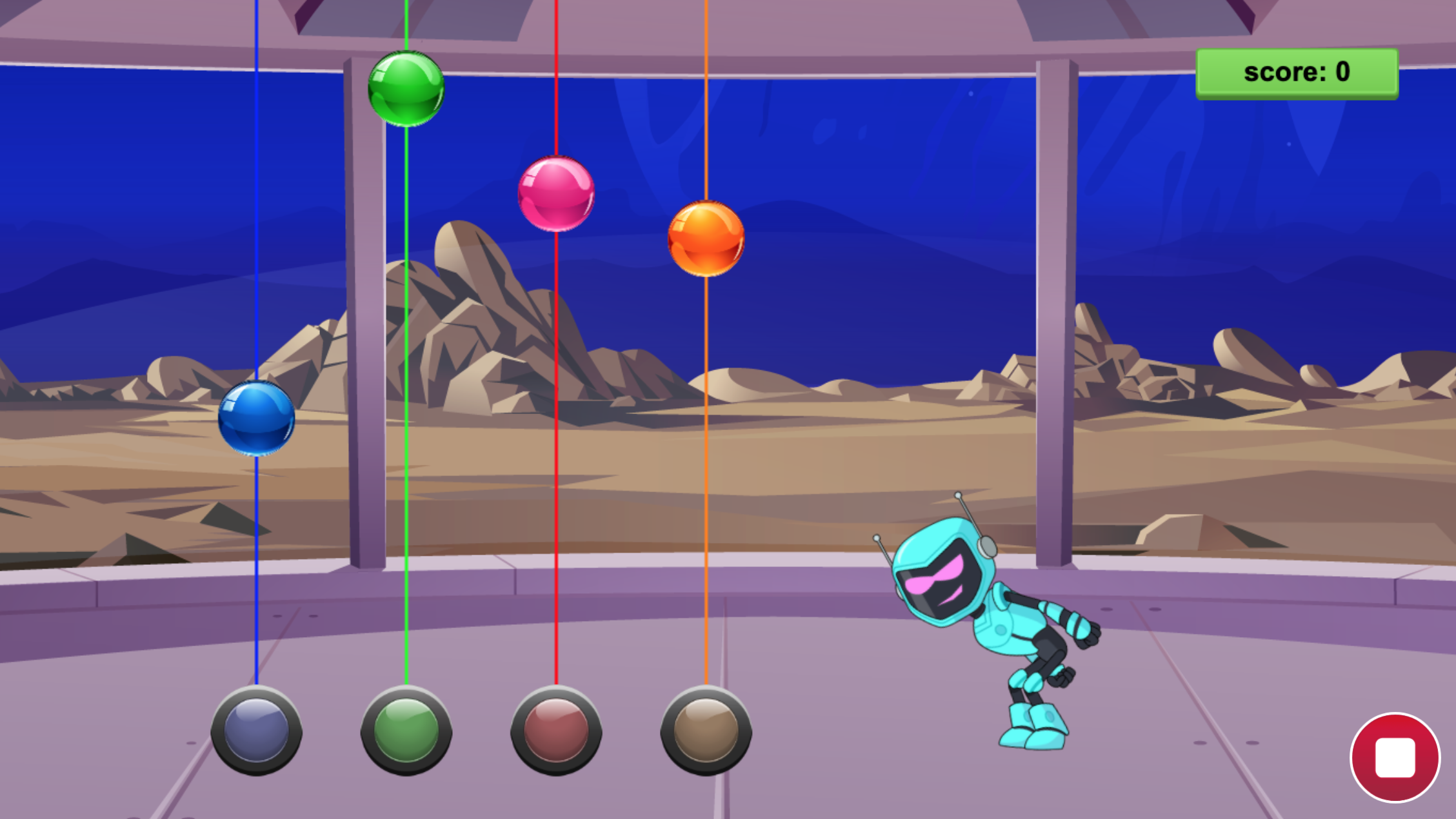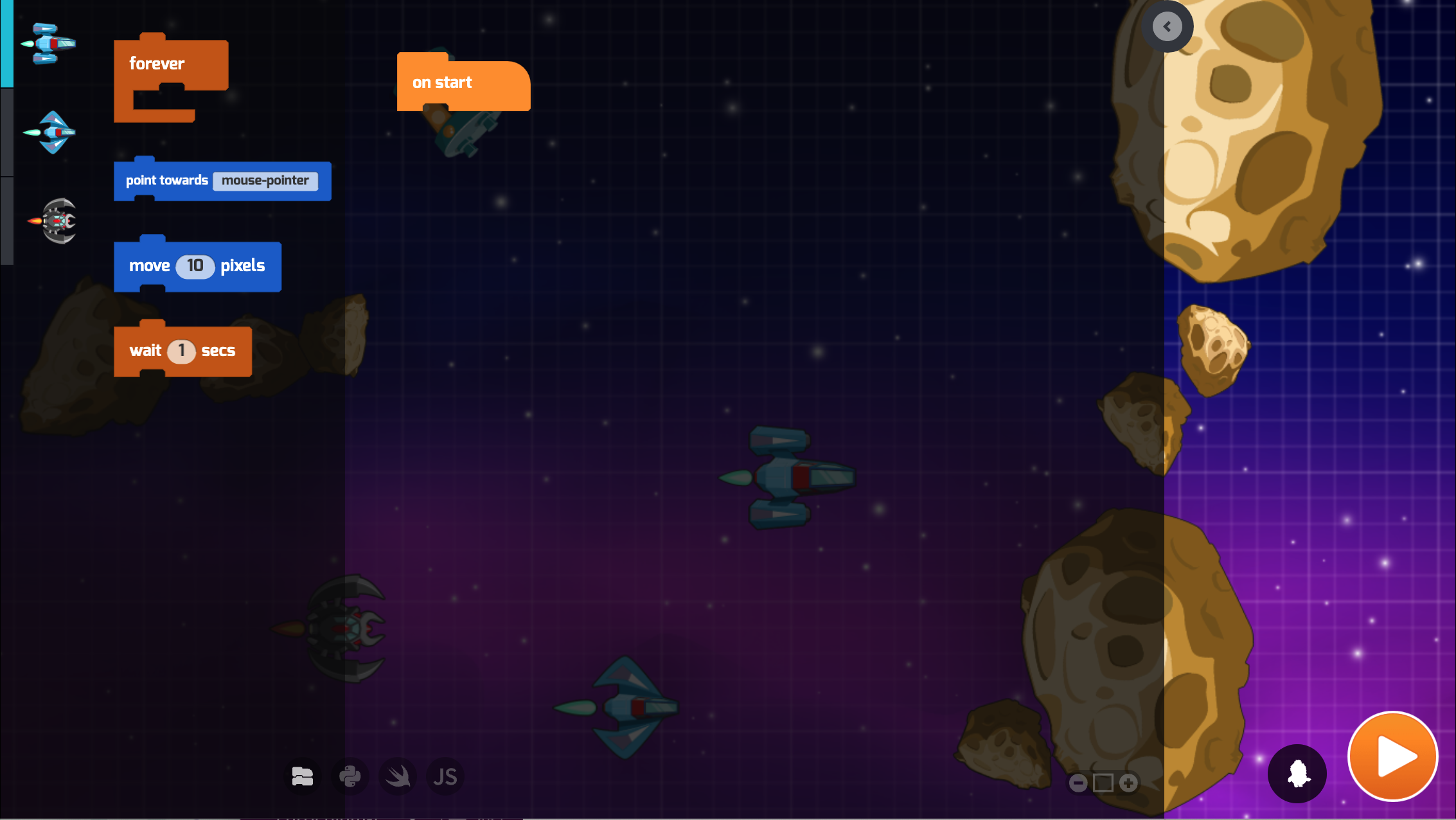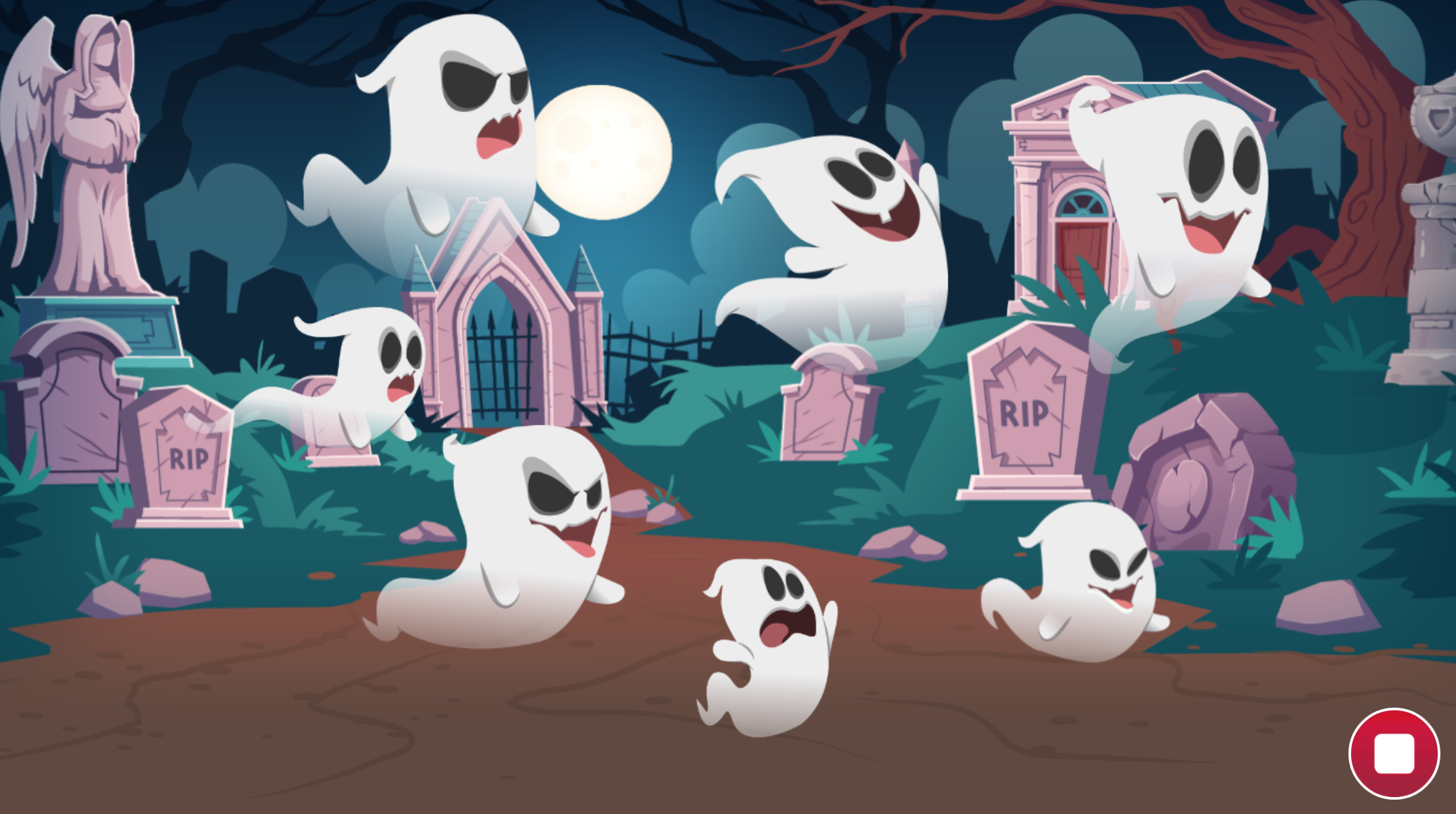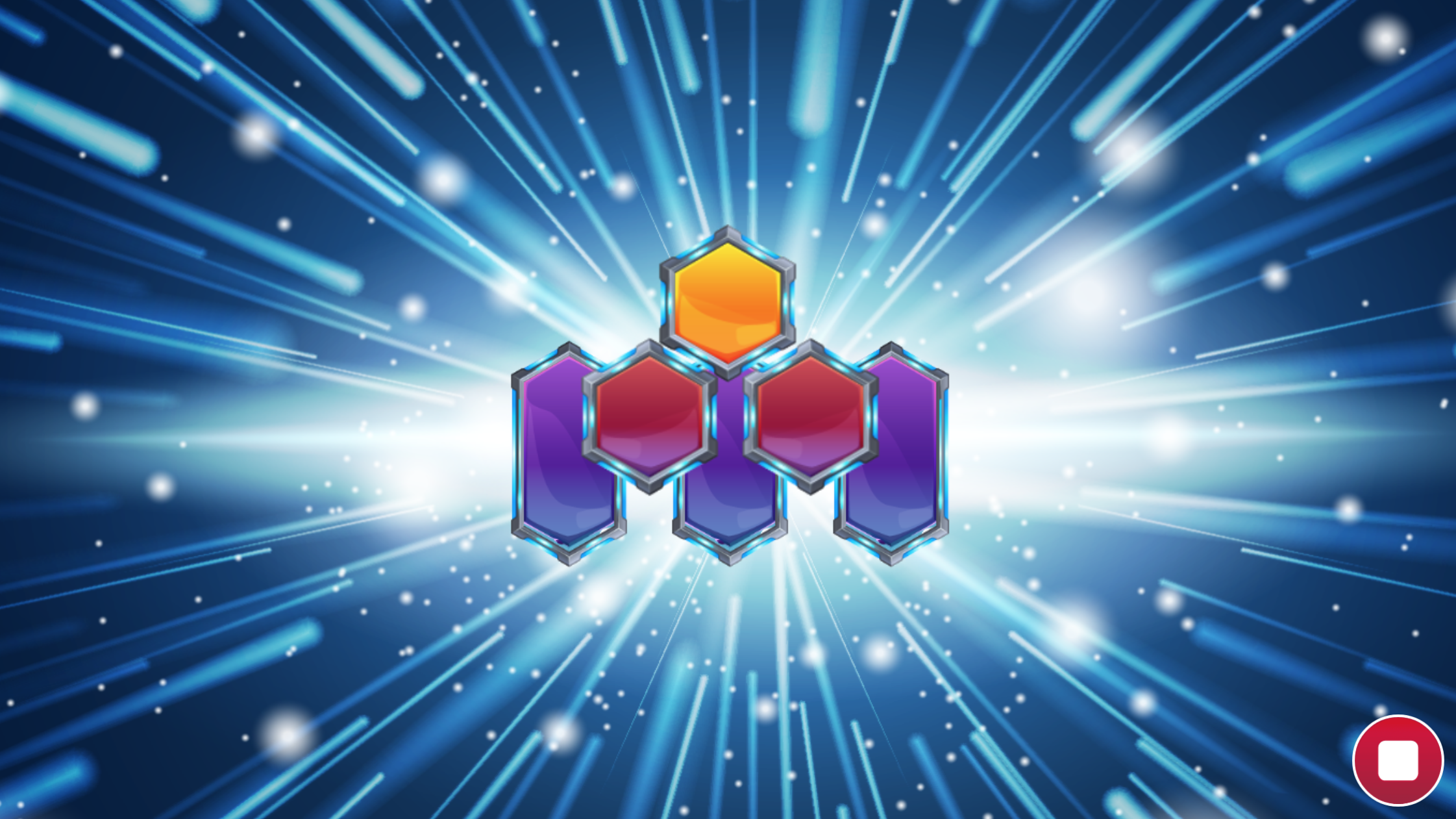Answer Key
Module 4: Animate the button

Module 7: Quiz
1.
-

True -
False
2.
-
True -

False
3.
-
{"func":"blockControlWait","values":[{"type":"number","value":""}]}
-

{"func":"blockSoundPlayUntilDone","values":[{"type":"string","value":""}]}
-
{"func":"blockLooksNextCostume"}
-
{"func":"blockLooksSwitchCostume","values":[{"type":"string","value":""}]}
4.
-
True -

False
5.
-

{"func":"blockLooksSwitchCostume","values":[{"type":"string","value":""}]}
-
{"func":"blockSoundPlay","values":[{"type":"string","value":""}]}
-
{"func":"blockControlForever","containers":[null]}
-

{"func":"blockLooksNextCostume"}
6.
{"func":"registerFlagTrigger","next":{"func":"blockControlWait","values":[{"type":"number","value":".5"}],"next":{"func":"blockLooksNextCostume","next":{"func":"blockControlWait","values":[{"type":"number","value":".5"}],"next":{"func":"blockLooksSwitchCostume","values":[{"type":"string","value":"blue button off"}]}}}}}
-

{"func":"blockControlForever","containers":[null]}
-
{"func":"blockControlRepeat","values":[{"type":"number","value":""}],"containers":[null]}
-
{"func":"blockLooksNextCostume"}
-
{"func":"blockLooksSwitchCostume","values":[{"type":"string","value":""}]}
7.
{"func":"blockLooksSwitchCostume","values":[{"type":"string","value":""}]}
{"func":"blockLooksNextCostume"}
{"func":"registerKeyTrigger","values":[{"type":"choice","value":"space"}],"next":{"func":"blockLooksNextCostume","next":{"func":"blockControlWait","values":[{"type":"number","value":".5"}],"next":{"func":"blockLooksSwitchCostume","values":[{"type":"string","value":"blue button off"}]}}}}
-

True -
False
8.
{"func":"registerFlagTrigger","next":{"func":"blockControlForever","containers":[{"func":"blockSoundPlayUntilDone","values":[{"type":"string","value":"Easy Rider - bass"}]}]}}
-
The background music will play repeatedly until the program is stopped -

The background music will only play once at the start of the program -
The background music will not play -
The background music will play if you click on the Actor
9.
{"func":"registerKeyTrigger","values":[{"type":"choice","value":"left arrow"}],"next":{"func":"blockLooksNextCostume","next":{"func":"blockControlWait","values":[{"type":"number","value":".5"}],"next":{"func":"blockLooksSwitchCostume","values":[{"type":"string","value":"blue button off"}]}}}}
-

The left arrow -
The space bar -
The right arrow -
The return key
10.
{"func":"registerKeyTrigger","values":[{"type":"choice","value":"left arrow"}],"next":{"func":"blockLooksNextCostume","next":{"func":"blockControlWait","values":[{"type":"number","value":".5"}],"next":{"func":"blockLooksSwitchCostume","values":[{"type":"string","value":"blue button off"}]}}}}
-
The button will change costumes more slowly than before -

The button will change costumes too fast to see -
The button will not change costumes -
The button will turn on and off twice
11.
-

{"func":"blockLooksSwitchCostume","values":[{"type":"string","value":""}]}
-
{"func":"blockLooksNextCostume"}
-
{"func":"blockSoundPlay","values":[{"type":"string","value":""}]}
-
{"func":"registerFlagTrigger"}
12.
-

True -
False
13.
{"func":"blockLooksNextCostume"}
-
True -

False
14.
{"func":"registerKeyTrigger","values":[{"type":"choice","value":"space"}],"next":{"func":"blockSoundPlayUntilDone","values":[{"type":"string","value":"Easy Rider - bass"}]}}
-

Plays the background music once when space is pressed -
Plays the background music forever when space is pressed -
Plays the background music forever when the program starts -
Plays the background music once when the program starts
15.
-
A 'Forever' loop runs the code blocks inside it once -
A 'Forever' loop repeats the code blocks inside it 10 times -

A 'Forever' loop repeats the code blocks inside it over and over until the program ends -
A 'Forever' loop repeats the code blocks inside it over and over even after the program ends
16.
-
{"func":"blockSoundPlay","values":[{"type":"string","value":""}]}
-

{"func":"blockControlForever","containers":[null]}
-
{"func":"blockControlWait","values":[{"type":"number","value":"1"}]}
-
{"func":"blockLooksSwitchCostume","values":[{"type":"string","value":""}]}
17.
-
Only in the code for the Stage -
Only in the code for an Actor -

Either in the code for an Actor or in the code for the Stage -
You do not need a code block to play background music in your program
18.
{"func":"blockLooksNextCostume"}
{"func":"blockSoundPlay","values":[{"type":"string","value":""}]}
-
The {"func":"blockLooksNextCostume"}
{"func":"blockSoundPlay","values":[{"type":"string","value":""}]}
-

The {"func":"blockLooksNextCostume"}
{"func":"blockSoundPlay","values":[{"type":"string","value":""}]}
-
Both of them are used to change the appearance of the Actor -
Both of them can be used to play sounds
19.
{"func":"blockLooksSwitchCostume","values":[{"type":"string","value":"blue button on"}],"next":{"func":"blockLooksSwitchCostume","values":[{"type":"string","value":"blue button off"}]}}
-
The button will be displaying the "blue button on" costume -

The button will be displaying the "blue button off" costume -
The button will be hidden -
The button will display both costumes at the same time
U.S. Standards
- CCSS-Math: MP.1
- CCSS-ELA: RF.5.4.A, 6-8.RST.3, 6-8.RST.4, 6-8.RST.7
- CSTA: 1B-AP-11, 1B-AP-12, 1B-AP-15, 2-AP-13, 2-AP-16, 2-AP-17
- CS CA: 3-5.AP.10, 3-5.AP.13, 3-5.AP.14, 3-5.AP.17, 6-8.AP.13, 6-8.AP.16, 6-8.AP.17
- ISTE: 1.c, 1.d, 4.d, 5.c, 5.d, 7.c
U.K. Standards
Key stage 2
Pupils should be taught to:- design, write and debug programs that accomplish specific goals, including controlling or simulating physical systems; solve problems by decomposing them into smaller parts
- use sequence, selection, and repetition in programs; work with variables and various forms of input and output
- use logical reasoning to explain how some simple algorithms work and to detect and correct errors in algorithms and programs
- understand computer networks, including the internet; how they can provide multiple services, such as the World Wide Web, and the opportunities they offer for communication and collaboration
- use search technologies effectively, appreciate how results are selected and ranked, and be discerning in evaluating digital content
- select, use and combine a variety of software (including internet services) on a range of digital devices to design and create a range of programs, systems and content that accomplish given goals, including collecting, analysing, evaluating and presenting data and information
- use technology safely, respectfully and responsibly; recognise acceptable/unacceptable behaviour; identify a range of ways to report concerns about content and contact
Key stage 3
Pupils should be taught to:- design, use and evaluate computational abstractions that model the state and behaviour of real-world problems and physical systems
- understand several key algorithms that reflect computational thinking [for example, ones for sorting and searching]; use logical reasoning to compare the utility of alternative algorithms for the same problem
- undertake creative projects that involve selecting, using, and combining multiple applications, preferably across a range of devices, to achieve challenging goals, including collecting and analysing data and meeting the needs of known users
- create, reuse, revise and repurpose digital artefacts for a given audience, with attention to trustworthiness, design and usability
- understand a range of ways to use technology safely, respectfully, responsibly and securely, including protecting their online identity and privacy; recognise inappropriate content, contact and conduct, and know how to report concerns
Description
An introduction to programming for beginners in upper elementary grades. Introduce your class to programming using a fun scenario-based approach where they build two complete games. Side Scroller Survival introduces them to basics of motion and animation. In BeatBot Battle, they program a robot to make it dance. On completing this lesson plan students will be able to build simple games, animations, and a variety of simple projects.
Topics
- Use sequencing
- Pattern recognition
- Loops
- Conditional logic
- Create scenes
- Add sounds and music
- Use keyboard controls
- Learn about motion
- Broadcasting messages
- Adding special effects
What Students Learn
- Create interactive scenes with actors, scenes and music
- Design animations using loops
- Program motion along x- and y-axes
- Build algorithms using conditional logic
- Understand scripts running in parallel
- Program music using notes, tempo and instruments
- Create different scenarios and effects in games
- Publish projects to the Web
- Troubleshoot and debug simple programs
Technical Requirements
* Online courses require a modern desktop computer, laptop computer, Chromebook, or Netbook with Internet access and a Chrome (29+), Firefox (30+), Safari (7+), or Edge (20+) browser. No downloads required.
* Tablet courses require an iPad (iOS 10+) with Tynker or Tynker Junior app installed and Internet access










